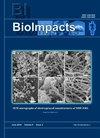The effects of Fe2O3 nanoparticles on catalytic function of human acetylcholinesterase: size and concentration role
IF 2.2
4区 工程技术
Q3 PHARMACOLOGY & PHARMACY
引用次数: 0
Abstract
Introduction: Fe2O3 NPs can enter cells quickly, pass through the blood-brain barrier and interact with macromolecules. These materials are widely used in different fields, so their risk assessment is among the most critical issues. Acetylcholinesterase (AChE) is a cholinergic enzyme in central and peripheral nervous systems. Methods: In this work, the possible effects of Fe2O3 NPs on the structure and catalytic activity of AChE were investigated using circular dichroism (CD), surface plasmon resonance (SPR), and fluorescence spectroscopies. Results: The outcomes demonstrated that 5 nm Fe2O3 NPs inhibit AChE activity through mixed mechanism. While 50 nm Fe2O3 NPs caused an enhancement in the catalytic activity up to 60 nM. However, higher concentrations of Fe2O3 NPs (above 60 nM) hindered the enzyme activity via mixed mechanism. Fluorescence analysis showed that NPs can quench the fluorescence intensity of AChE that refer to conformational changes. Furthermore, CD results showed that Fe2O3 NPs can reduce the α-helix and β-sheet contents of the enzyme and decrease the stability of AChE. Also, the SPR data analysis showed that the affinity between AChE and Fe2O3 NPs decreased with rising temperature. After treatment with Fe2O3 NPs, the catalytic activity of AChE was assessed in HepG2 cell lines, and the results confirmed the inhibitory effects of Fe2O3 NPs on AChE activity in vivo. Conclusion: These findings provide helpful information about the impact of Fe2O3 NPs on the structure and function of AChE and could offer new insights into the risk assessment of the medical application of nanoparticles.Fe2O3 纳米粒子对人乙酰胆碱酯酶催化功能的影响:尺寸和浓度的作用
简介Fe2O3 NPs 可快速进入细胞,通过血脑屏障,并与大分子相互作用。这些材料被广泛应用于不同领域,因此其风险评估是最关键的问题之一。乙酰胆碱酯酶(AChE)是中枢和外周神经系统中的一种胆碱能酶。研究方法本研究采用圆二色性(CD)、表面等离子体共振(SPR)和荧光光谱法研究了 Fe2O3 NPs 对 AChE 的结构和催化活性可能产生的影响。结果表明结果表明,5 nm Fe2O3 NPs 通过混合机制抑制 AChE 活性。而 50 nm 的 Fe2O3 NPs 会增强 AChE 的催化活性,最高可达 60 nM。然而,更高浓度的 Fe2O3 NPs(超过 60 nM)会通过混合机制阻碍酶的活性。荧光分析表明,NPs 能淬灭 AChE 的荧光强度,这与构象变化有关。此外,CD 结果表明,Fe2O3 NPs 能降低酶的α-螺旋和β-片的含量,降低 AChE 的稳定性。SPR 数据分析还表明,AChE 与 Fe2O3 NPs 的亲和力随温度升高而降低。用 Fe2O3 NPs 处理后,在 HepG2 细胞系中评估了 AChE 的催化活性,结果证实了 Fe2O3 NPs 对体内 AChE 活性的抑制作用。结论这些发现为了解 Fe2O3 NPs 对 AChE 结构和功能的影响提供了有用的信息,并可为纳米粒子医疗应用的风险评估提供新的见解。
本文章由计算机程序翻译,如有差异,请以英文原文为准。
求助全文
约1分钟内获得全文
求助全文
来源期刊

Bioimpacts
Pharmacology, Toxicology and Pharmaceutics-Pharmaceutical Science
CiteScore
4.80
自引率
7.70%
发文量
36
审稿时长
5 weeks
期刊介绍:
BioImpacts (BI) is a peer-reviewed multidisciplinary international journal, covering original research articles, reviews, commentaries, hypotheses, methodologies, and visions/reflections dealing with all aspects of biological and biomedical researches at molecular, cellular, functional and translational dimensions.
文献相关原料
| 公司名称 | 产品信息 | 采购帮参考价格 |
|---|
 求助内容:
求助内容: 应助结果提醒方式:
应助结果提醒方式:


